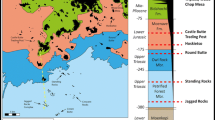Abstract
The Mesoproterozoic Rivard minette dyke provides a case example of dyke-parallel fracturing induced by propagation of low-viscosity melts at deep crustal levels. The dyke constitutes a xenolith-choked intrusion breccia and provides samples of an extensive section of the lithosphere underlying the southwestern Grenville Province of Québec at 1.08 Ga. The xenoliths occupy approximately 50% of the volume of the breccia. They are extremely diverse and include pyroxenites and mafic granulites from the upper mantle and lower crust, and Grenvillian gabbroids, gneisses and quartzites. Wall-rock fragments are detached to various extents along dyke-parallel fractures and apophyses. The host lamprophyre magma has a calculated viscosity of ca. 40 Pa·s. Rapid ascent of magma and turbulence are suggested by the presence of large dense fragments and the brittle-to-ductile deformation at the margins of some xenoliths. A minimum ascent velocity of ca. 50 cm·s–1 is estimated from the settling velocity of a 40 cm long pyroxenite xenolith. The progressive addition of xenoliths increased the effective viscosity of the liquid-solid mixture to 103 Pa·s during emplacement. This favoured Bingham behaviour and laminar flow of the magma, and xenolith suspension. Field evidence suggests that xenoliths were formed through (1) early fracturing of wall rock by inelastic deformation during dyke propagation, and (2) continuous delamination of wall rock by intrusion of magma along the dyke-parallel fractures. This led to removal of chilled margins, and to fluid infiltration, partial melting and microbrecciation in the wall rock. Pre-existing discontinuities played a minor role in the fracturing process. Xenoliths may thus be abundant in alkaline magmas not only because these magmas ascend rapidly and can transport xenoliths, but possibly also, because their low viscosities promote intense fracturing of wall rock.
Similar content being viewed by others
Author information
Authors and Affiliations
Additional information
Received: 10 June 1995 / Accepted: 10 February 1996
Rights and permissions
About this article
Cite this article
Morin, D., Corriveau, L. Fragmentation processes and xenolith transport in a Proterozoic minette dyke, Grenville Province, Québec. Contrib Mineral Petrol 125, 319–331 (1996). https://doi.org/10.1007/s004100050225
Issue Date:
DOI: https://doi.org/10.1007/s004100050225




